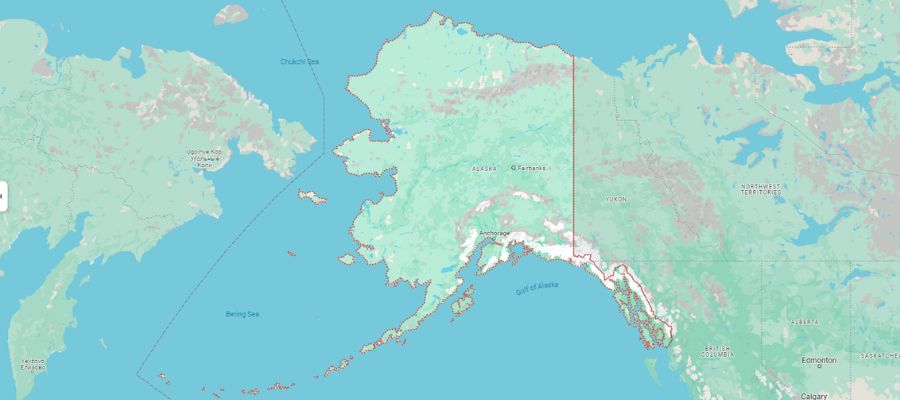Mainly spoken by inhabitants of Western and South-Central Alaska, Yupik speech and language development contains many interesting features that are worth noting by professionals working with families or children who are Yupik speakers so that we know what to focus on in the classroom or speech therapy sessions. This is a fun essay to introduce you to the dynamically rich history and culture and then identify specific differences between Yupik and English.
Spoken by roughly over 20,000 people, the Yupik language lives vibrantly throughout the Western and Southern coast of Alaska. Yupik belongs to a family of languages called the Eskaleut languages, which are languages native to northern parts of North America. The Eskaleut language family can be divided into two parts- the Eskamoen and the Aluet branches. The Aluet branch consists solely of the Aluet language, while the Eskamoen branch can be further divided into two subcategories- the Yupik languages, spoken in Southwestern Alaska, and Inuit languages, spoken in Northern Alaska, Canada, and Greenland.
The Yupik language is interesting in that while the name of the spoken language is Yupik, the people who speak Yupik are also referred to as Yupik people. The term Yupik comes from “yuk” meaning person, and “pik” meaning real. An interesting belief held by Yupik people is that people never truly die, rather their souls are reborn into other generations.

Interesting Facts About Yupik Speech and Language Development
There are many things to learn from Yupik people’s culture and language, as it has been passed on for over 3,000 years! Some interesting facts regarding the Yupik language include:
- Yupik people cherish the rich oral tradition of myths, stories, histories, and songs past down by generations (often elders/ grandparents to children and grandchildren)
- There are several types of Yupik languages, and they differ so much from one another that they are not mutually intelligible, but it’s likely that a speaker of one language is able to grasp main ideas of another spoken language
- Unfortunately, one of the Yupik languages, Nuakan Siberian Yupik, is on the list of critically endangered languages. This means that the youngest speakers are grandparents and older and they speak the language either partially or infrequently, so the transfer to younger generations is unlikely to occur
Yupik Speech and Language Development
Yupik Consonants in Comparison to English
| Yupik Consonants Not Shared with English | /q/ /x/ /ʁ/ /ɣ/ /χ/ /ɬ/ |
| Consonants Shared With English | /m/ /n/ /ŋ/ /p/ /t/ /k/ /tʃ/ /f/ /s/ /v/ /z/ /j/ /w/ /l/ |
| English Consonants Not Shared with Yupik | /b/ /d/ /g/ /ʃ/ /ʒ/ /dʒ/ /h/ /ð/ /θ/ /ɹ/ |
Yupik Vowels in Comparison to English
| Yupik Vowels Not Shared with English | N/A |
| Vowels Shared With English | /a/ /e/ /ə/ /i/ /u/ |
| English Vowels Not Shared with Yupik | /ɚ/ /ɔ/ /o/ /ɛ/ /ʌ/ /ʊ/ /I/ /æ/ |
The Use of Phonotactic Constraints in Yupik Speakers
It’s important to consider the specific speech patterns that occur when native Yupik speakers speak English:
- No tautosyllabic consonant clusters
- Very few hetero-syllabic adjacent fricatives
- Deletion & epenthesis are preferred to adjacent fricatives
- Nasal consonant can appear after other consonants with differing manner of articulation
- Lack consonant assimilation
- Typically only three vowels /a/ /i/ /u/, though some dialects include /ə/
- Lack of ejectives
- Use of contrasting voiceless nasals
Language Specific Differences Between English and Yupik
While there are many similarities to the structure of English, Yupik language structure is incredibly unique leading to differences in grammar and use. Highlighting these differences can lead to better goal selection for what to focus on in the classroom or therapy sessions.
| Feature | Yupik | English |
|---|---|---|
| Sentence Word Order | No strict word order, but preference for Subject-Object- Verb order | Strict Subject-Verb Object order |
| Adjectives/Noun modifiers | Uncommon (nominal derivational affixes and roots fill this role) | Adjective-Noun order |
| Possessives | Possessives divided into two categories: absolutive and ergative | Marked with morpheme ‘s for singular nouns and s’ for plural nouns Possessive adjectives (i.e. my, their) and pronouns (i.e. mine, theirs) also exist |
| Possessive Pronouns | -ka (my), -puk (our), -n (your), -a (his), -ak (their) | Mine, yours, his, hers |
| Verb inflection | Verb word= verb base + verb inflection | 2 present tense forms: I eat You eat He/She/It eats We eat They eat |
| Pronouns | Exist | Exist |
| Pronoun Gender | None | He, She, It |
| Subject of Sentence | Subject stated specifically or with pronouns in each sentence | Subject stated specifically or with pronouns in each sentence. |
| Regular Past Tense | Different tense system | One form (-ed) |
| Irregular Past Tense | Different tense system | Exist |
| Negatives | “Nrite-” =not, “-ngaite-”= will not, combines tense and negation | “not” follows the copula, precedes any other verb |
| Double negatives | Not allowed? | Not allowed |
| Definite Articles | None | the |
| Indefinite Articles | None | a, an |
| Prepositions | Uncommon (Yupik grammatical case fills this role) | Specific words that precede a noun and its article Must be included Used for various functions (time, space, quantities, direction, etc.) but there are no standard rules on use |
| Present Progressive Verb Form | Exists | Exists |
| Modal Verbs | Exist | Exist (I may be late). |
| Copula/”To Be” Verb | Copulative ‘u’ | Used with nouns and adjectives (I am a boy. I am hungry.) |
| Auxiliary Verbs | Do not exist | Exist |
| Passive Voice | Expressed through postbases | Object precedes the verb and stating the subject is optional (His hair was cut by the woman) |
| Direct Object Pronouns | Not sure | |
| Conjunctions | Exist (example “wall’u”= or) | Conjoins ideas with a conjunction word (and, but, or) |
| Plurals | Exist- single morpheme added to ending | Add –s (–es to nouns ending in s, ch, x, z) and some irregular plurals (i.e. children) Uncountable nouns are singular (i.e. information) |
| Subject-Verb Agreement | Subject-verb-object agreement required | Required |
| Grammatical Case and Gender | Nouns do not have a case system. Personal pronouns have 3 cases: nominative (subject pronouns), accusative (direct object pronouns) and genitive (possessive pronouns). Gender is only specified in personal pronouns and in some natural gender nouns (i.e. mother is feminine) and some noun suffixes (i.e. chairman, waitress) Verbs, adjectives and adverbs do not carry gender information | |
| Negation | Word followed with “te” to express negation | “Not” follows the copula, precedes any other verb “Not” comes before an auxiliary verb Contractions (i.e. isn’t, aren’t, hasn’t, don’t, haven’t) Double negatives not allowed |
| Verb Tense, Aspect and Mood | Expressed through “postbases”- tenses of Yupik don’t quite match that of the English tense system MANY moods in Yupik- Grammatical mood can be categorized according to whether clause is independent or subordinate | 2 tenses: Present, 2 inflections (add –s to 3rd person singular only) Past, 1 inflection (suffix –ed and irregular verbs) Future tense is expressed through modal verbs (i.e. will, shall) 4 aspects: simple, progressive (copula to be + present/past participle), perfect (copula to have + present/past participle), perfect progressive (to have + to be + present/past participle) Present participles add suffix –ing Past participles add suffix –ed (i.e. studied), -en (i.e. taken), or use stem change (i.e. begun) |
| Verb Voice | No “active” or “passive” voices, passive voice can be expressed by post bases | 2 voices: active and passive In passive the voice object precedes the verb and stating the subject is optional (i.e. His hair was cut by the woman.) Different forms are used for active and passive meanings |
| Pronouns | Not used often- verb and noun endings take their place | Replace noun with pronoun (noun or pronoun is always required) Personal pronouns include subject, object, and reflexive. Masculine, feminine and neutral pronoun used 2nd person plural pronoun doesn’t exist No differentiation in gender for 3rd person plural pronoun Indefinite (i.e. each, somebody), demonstrative (i.e. this, those), interrogative (i.e. who, what), possessive (mine, his) and relative pronouns (i.e. that, which), are also used |
| Relative Pronouns | Not sure | Used to connect a clause or phrase to a noun or pronoun (who, whom, whose, which, that) |
| Adverbs | Adverbs occur | Adverbs occur in various positions according to rules |
| Comparative and Superlative | Exist | Uses –er with comparative and –est with superlative More (comparative) and most (superlative) are used with adjectives of more than two syllables Irregular forms (i.e. worst, furthest) |
Sources:
A Grammatical Sketch of Siberian Yupik Eskimo . Alaska Public Library. (n.d.).
Contributors to Martial Arts Kids Wiki. (n.d.). Yupik. Martial Arts Kids Wiki.
The syntax of negation in St. Lawrence Island/central Siberian yupik. (n.d.-a).
Wikimedia Foundation. (2023a, October 8). Eskaleut languages. Wikipedia.
Wikimedia Foundation. (2023b, October 19). Yupik languages. Wikipedia.
YouTube. (2015, June 9). Nova gold – yup’ik language. YouTube.
Yup’ik eskimo dictionary – swrsd.org. (n.d.-b).
Contributing Researchers:
A special thanks to Paige G. Freund wit Concordia University- Wisconsin for data compilation and research that went into this article!



